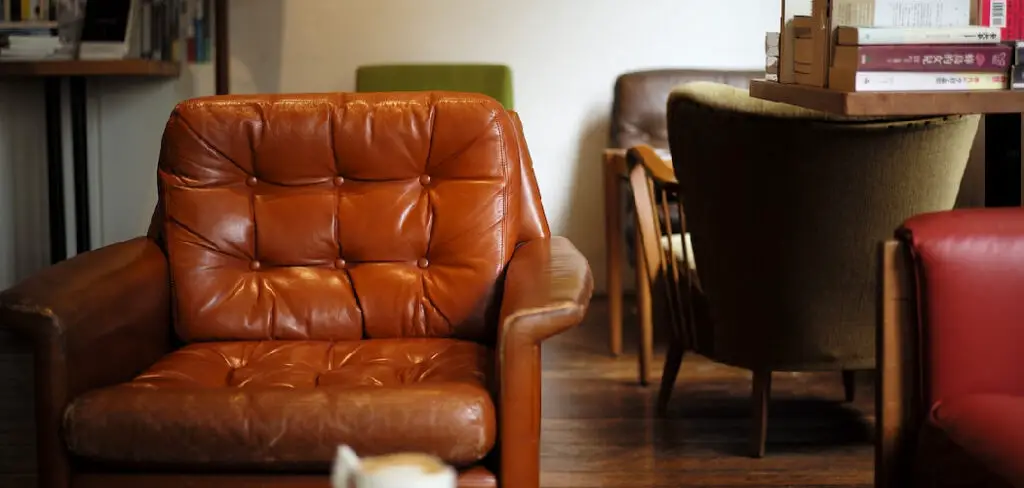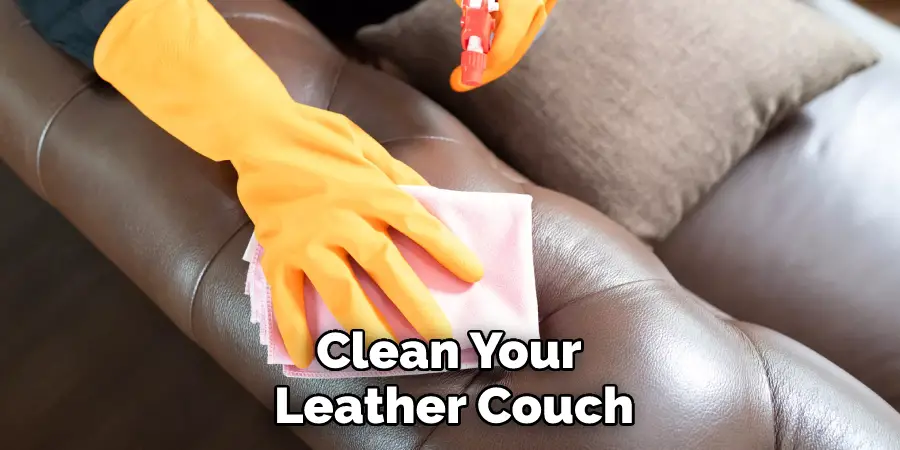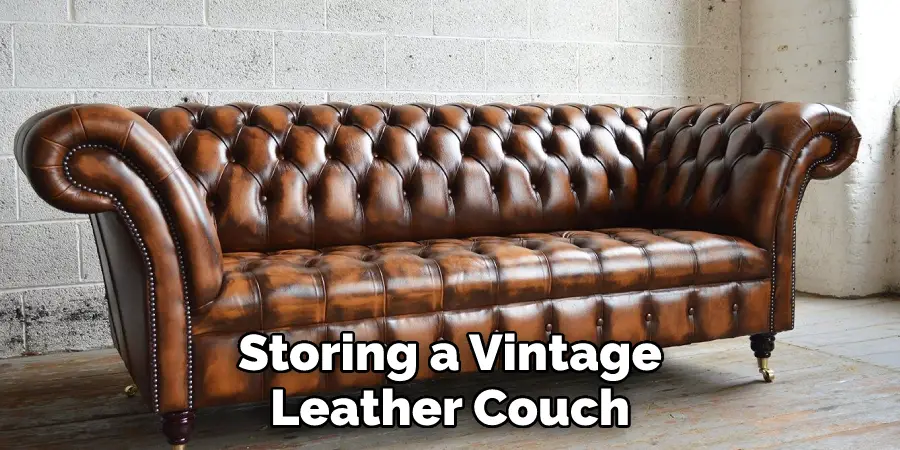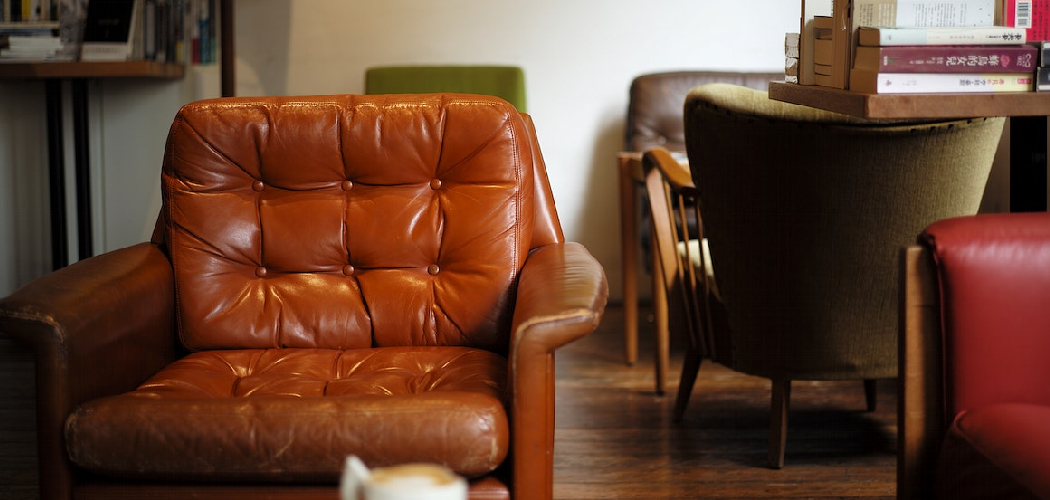Storing a leather couch is important because it helps to protect your furniture investment. Leather is expensive and can wear down quickly if not properly taken care of.

With proper storage techniques, you can keep your leather couch in like-new condition for years to come. Properly storing a leather couch can also help prevent damage from humidity, dust, and other elements that can damage the furniture over time.
Storing a leather couch offers many advantages compared to other types of furniture. Leather is naturally resistant to water, heat, stains, and fading, so it can be stored safely in locations that may not be ideal for storing other materials.
This makes the storage process easier and less costly, as you won’t have to purchase additional items or materials like furniture covers or blankets. You can find step-by-step instructions on how to store a leather couch in this blog article.
Step-by-step Instructions for How to Store a Leather Couch
Step 1: Inspect the Couch
Before you store your leather couch, inspect the piece of furniture for any damage or blemishes. These will need to be addressed before storage. Check for tears, holes, scratches, fading, and other signs of wear. If necessary, repair any damage before you proceed with storage.
Step 2: Clean the Couch
Once you’ve inspected the couch, it’s time to clean it well. Leather couches may accumulate dust and dirt over time, so use a damp cloth to wipe away any debris before you store it. You can also use an upholstery cleaner or gentle leather conditioner to help keep your couch in tip-top shape.
Step 3: Dry the Couch Thoroughly
It’s important to ensure your leather couch is completely dry before you store it. Use a microfiber cloth or paper towels to absorb any excess moisture. Be sure to wipe down all surfaces, including any crevices and seams, as well as underneath cushions and pillows.
To keep your leather couch looking and feeling its best, you should apply a leather protectant before storing it away. This will help preserve your furniture’s look and prevent any cracking or fading due to exposure to outdoor elements.
Step 4: Prepare the Storage Area
Before storing your leather couch, preparing the storage area is important. Choose a cool and dry place for the couch, such as a basement or attic. Make sure that the area is clean and free from dust, dirt, and other debris. You may also want to cover the floor with plastic sheeting to further protect against any potential damage.

To keep your leather couch safe and secure, wrap it up in either plastic or fabric before storage. You can use a heavy-duty plastic drop cloth or an old blanket to protect against dirt and dust. For added protection, you can also cover each individual component of the couch for added security.
Step 5: Lift and Place the Couch in the Storage
Once you have wrapped up your leather couch, it’s time to lift and place it into the storage area. Use furniture sliders or a dolly to make moving the piece of furniture easier.
Be sure to keep the weight evenly distributed so that your furniture doesn’t become unbalanced or tip over during the move. Before you use the leather couch again, it’s important to re-inspect it for any potential damage that may have occurred during storage. Wipe away any dust and dirt with a damp cloth or upholstery cleaner.
Step 6: Re-Condition Leather Sofa
To maintain the shine and smoothness of your leather sofa, you should re-condition it after storage. Use a quality leather conditioner to restore any lost oils and moisture while protecting against sun damage, fading, and cracking.
Lastly, enjoy your leather couch once more! Make sure to take proper care of it going forward with regular dusting and conditioning. With the right storage methods and maintenance, you can keep your leather furniture looking like new for years to come.
Precautions for How to Store a Leather Couch
- Clean your leather couch before storing it, especially if you plan on long-term storage. Use a leather cleaner and conditioner to maintain the leather’s natural oils, helping to prevent drying or cracking when in storage.
- Choose a dry, dark location for your leather couch that is free from dirt and dust particles, as any of these elements can cause discoloration or staining on the leather.
- Cover your leather couch with a heavy-duty plastic tarp to protect it from dust and dirt buildup and prevent direct sunlight exposure, which could cause fading.
- Place your leather couch on a pallet in order to keep moisture away.
- If storing your leather couch in a humid environment, place desiccants such as silica gel or charcoal briquettes around it to absorb any moisture and keep it dry.
- Place an air-circulating fan nearby to help reduce the humidity without creating too much air circulation near the leather, which can cause drying or cracking over time.
- Check on the leather couch regularly during storage to make sure it is still in good condition and has not sustained any damage from being in storage. If you notice any signs of deterioration, take appropriate steps immediately to address the issue before further damage can occur.

What Environmental Factors Should You Consider When Storing Your Leather Couch?
When storing a leather couch, it is important to consider the environment where you are storing it. Leather couches are sensitive to temperature, humidity, and light changes which can cause them to crack and fade if stored in an unsuitable environment. Protecting your leather couch from environmental factors like extreme temperatures, moisture, dust, and direct sunlight is essential.
Ideally, you want to store your leather couch in a location that is climate-controlled and away from any windows or outside walls. This will help ensure that the temperature and humidity levels remain consistent to prevent damage to the leather.
If you are unable to keep your leather couch in a temperature-controlled environment, consider using a dehumidifier to help reduce the humidity in the room.
How Can You Prepare Your Leather Couch for Long-term Storage?
When you’re getting ready to store your leather couch for a long time, it’s important to take the right precautions to ensure that your couch is preserved and safe. Before you even start packing up your furniture, make sure that you clean the entire piece with a gentle leather cleaner.
This will help prevent dirt, dust, and other debris from settling on the surface while in storage. Once your leather is clean, condition it with a leather protectant. This will help keep the material hydrated and prevent cracking or fading during its time away.
Once your couch is prepped and ready to go, you’ll want to start packing it up. It’s best to use furniture covers or plastic wrap in order to keep dust and other elements off the material while it’s in storage. Make sure to use a cushion cover or foam padding as well to provide extra protection.

When it comes time to move the couch, use moving blankets and straps so that you don’t damage it. Finally, make sure to choose a storage space that is suitable for the leather couch. This means selecting an area where temperatures and humidity levels are consistent, as too much moisture can cause mold and mildew growth on the material.
How Do You Clean Your Leather Couch Before Storing?
Before storing your leather couch, cleaning and conditioning it properly is important. This will help prevent cracking or discoloration while in storage. Start by thoroughly vacuuming your couch’s surface with a soft brush attachment. Use a mild detergent mixed with warm water and a soft cloth for tougher spots to remove dirt, debris gently, and any spills.
After cleaning your couch, you should apply a leather conditioner to help it stay pliable and soft during storage. This will also help protect against water damage or fading that may occur in extreme temperatures or humidity levels. Once the conditioner has been applied, allow the couch to dry completely before moving on with storing it.
Your leather couch should now be clean, conditioned, and ready for storage. Ensure you follow any additional instructions given by the manufacturer to ensure your couch is stored safely and correctly. With proper care and handling, your couch can stay in perfect condition for many years of use.

Are There Any Special Considerations for Storing a Vintage or Antique Leather Couch?
If you are storing a vintage or antique leather couch, there are a few extra considerations to keep in mind. First, ensure the storage unit is climate controlled to protect your furniture from extreme temperatures and humidity. It’s also important to keep the leather couch away from direct sunlight as it can cause fading or cracking.
It’s best to cover the couch with a sheet of plastic before placing it in storage to protect it from dust and dirt. Lastly, make sure you check up on your leather couch at least once every few months to ensure that all is well. If you notice any signs of damage, take steps to care for it as soon as possible. Taking these extra precautions will help ensure that your vintage or antique leather couch remains pristine for years to come.
Following the guidelines above, you can safely and securely store a leather couch. A little preparation goes a long way when it comes to protecting your furniture, so make sure you take the time to prepare properly before placing your leather couch in storage.

Conclusion
In conclusion, storing a leather couch can be a challenge. However, with the right preparation and storage solutions, you can keep your couch looking new for years. Start by cleaning and conditioning your leather before packing it away.
Invest in furniture covers or a suitable storage container designed specifically for leather protection. Choose a cool, dry location that’s free from direct sunlight and away from other furniture or items that may cause damage.
Finally, don’t forget to periodically open the storage container to allow your leather couch to breathe. I hope this article has been beneficial for learning how to store a leather couch. Make Sure the precautionary measures are followed chronologically.

